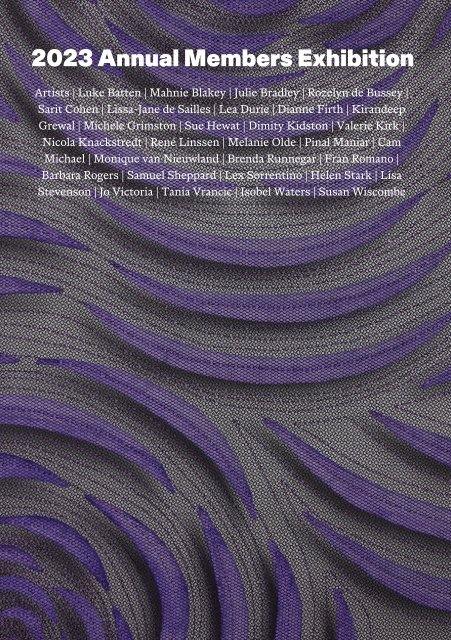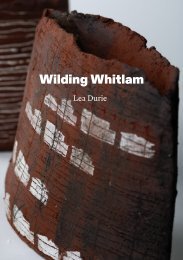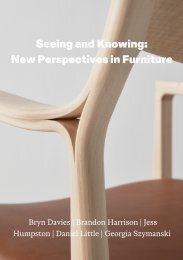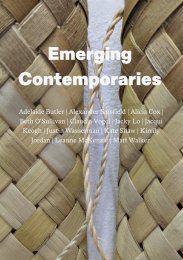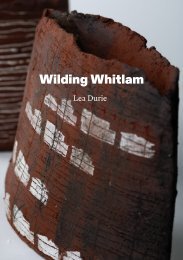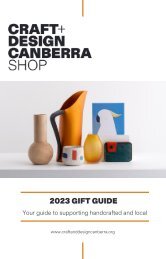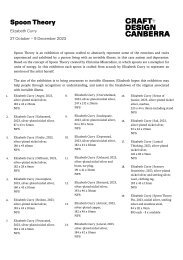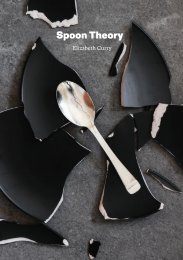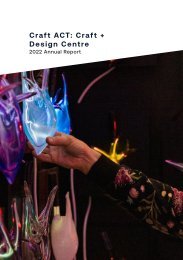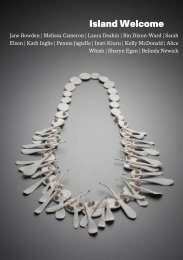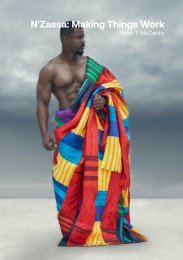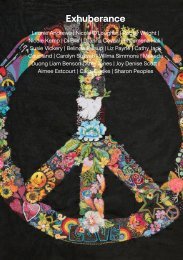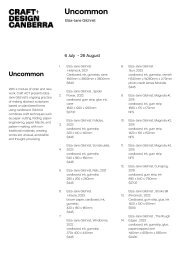2023 Members Exhibition Catalogue
You also want an ePaper? Increase the reach of your titles
YUMPU automatically turns print PDFs into web optimized ePapers that Google loves.
<strong>2023</strong> Annual <strong>Members</strong> <strong>Exhibition</strong><br />
Artists | Luke Batten | Mahnie Blakey | Julie Bradley | Rozelyn de Bussey |<br />
Sarit Cohen | Lissa-Jane de Sailles | Lea Durie | Dianne Firth | Kirandeep<br />
Grewal | Michele Grimston | Sue Hewat | Dimity Kidston | Valerie Kirk |<br />
Nicola Knackstredt | René Linssen | Melanie Olde | Pinal Maniar | Cam<br />
Michael | Monique van Nieuwland | Brenda Runnegar | Fran Romano |<br />
Barbara Rogers | Samuel Sheppard | Lex Sorrentino | Helen Stark | Lisa<br />
Stevenson | Jo Victoria | Tania Vrancic | Isobel Waters | Susan Wiscombe
Craft + Design Canberra is partially supported by the ACT<br />
Government, the Visual Arts and Craft Strategy - an<br />
initiative of the Australia State and Territory Governments,<br />
and the Australia Council for the Arts - the Australian<br />
Government's arts funding and advisory body.<br />
Craft + Design Canberra acknowledges the Ngunnawal<br />
people as the traditional custodians of the ACT and<br />
surrounding areas. We honour and respect their ongoing<br />
cultural and spiritual connections to this country and the<br />
contribution they make to the life of this city and this<br />
region. We aim to respect cultural heritage, customs, and<br />
beliefs of all indigenous people.<br />
Craft + Design Canberra<br />
Wednesday - Saturday | 12-4pm<br />
Or by appointment.<br />
Level 1, North Building | 180 London Circuit<br />
Canberra ACT Australia<br />
02 6262 9333<br />
www.craftanddesigncanberra.org<br />
Publisher: Craft + Design Canberra<br />
Research, writing, and coordination: Christian Sirois<br />
Graphic Design Template: Llewellyn McGarry<br />
ABN 33 314 092 587<br />
© Craft + Design Canberra<br />
Cover Image | Dianne Firth, Turbulence, 2022 | Photo Courtesy of Artist
<strong>2023</strong> Annual <strong>Members</strong> <strong>Exhibition</strong><br />
Artists | Luke Batten | Mahnie Blakey | Julie Bradley | Rozelyn de Bussey<br />
| Sarit Cohen | Lissa-Jane de Sailles | Lea Durie | Dianne Firth | Kirandeep<br />
Grewal | Michele Grimston | Sue Hewat | Dimity Kidston | Valerie Kirk |<br />
Nicola Knackstredt | René Linssen | Melanie Olde | Pinal Maniar | Cam<br />
Michael | Monique van Nieuwland | Brenda Runnegar | Fran Romano |<br />
Barbara Rogers | Samuel Sheppard | Lex Sorrentino | Helen Stark | Lisa<br />
Stevenson | Jo Victoria | Tania Vrancic | Isobel Waters | Susan Wiscombe<br />
27 October – 9 December<br />
<strong>2023</strong> CRAFT + DESIGN CANBERRA
Image: Artist name, work title, year. Photo: Photo Credit.<br />
Image Nicola Knackstredt | Untamed, <strong>2023</strong> | Photo Courtesy of Artist
Image Melanie Olde | Cell System 1, <strong>2023</strong> |Photo Courtesy of Artist.
<strong>2023</strong> Annual <strong>Members</strong> <strong>Exhibition</strong><br />
EXHIBITION STATEMENT<br />
The <strong>2023</strong> Craft + Design Canberra<br />
Annual <strong>Members</strong> <strong>Exhibition</strong><br />
showcases contemporary expressions<br />
of craft and design uniting timehonoured<br />
techniques with modern<br />
interpretations. This exhibition<br />
showcases the trends in<br />
contemporary craft and design in<br />
Australia by local practitioners.
Image Fran Romano | Containment II, <strong>2023</strong> | Photo Andrew Sikorski - Art Atelier
Image: Artist name, work title, year. Photo: Photo Credit.<br />
Image Fran Romano | Containment II, <strong>2023</strong> | Photo Andrew Sikorski - Art Atelier
<strong>2023</strong> Annual <strong>Members</strong> <strong>Exhibition</strong><br />
Foreword by Christian Sirois<br />
<strong>Members</strong> are at the heart of Craft +<br />
Design Canberra, contributing to its<br />
vibrancy and vitality. Their creative<br />
talents and dedication infuse the<br />
organisation with fresh ideas and<br />
perspectives, ensuring that it<br />
remains a dynamic force within our<br />
community, and the local and<br />
national creative and cultural<br />
landscape. The collaborative nature<br />
of our members not only<br />
strengthens our organisation but<br />
also serves as a testament to the<br />
power of collective creativity in<br />
building a robust and culturally rich<br />
community.<br />
Creative development of our artists<br />
is a core goal of Craft + Design<br />
Canberra, nurturing the artistic<br />
growth of both individuals and the<br />
wider community. By encouraging<br />
experimentation and innovation,<br />
Craft + Design Canberra instils a<br />
culture of constant evolution and<br />
adaptation. This commitment to<br />
creative development empowers<br />
artists to push boundaries, solve<br />
problems innovatively, and express<br />
complex ideas in unique ways,<br />
while the broader community reaps<br />
the benefits the more vibrant and<br />
forward-thinking environment,<br />
these artists contribute to.<br />
In summary, Craft + Design<br />
Canberra through its emphasis on<br />
ingenuity, the championing of local,<br />
and member participation, stands as<br />
a model of the importance of craft<br />
and design in communities. It<br />
enriches culture, nurtures<br />
creativity, promotes inclusivity,<br />
and drives positive change within<br />
the Australian Capital Territory and<br />
beyond. Through organizations like<br />
ours, communities harness the<br />
creative energies of their members,<br />
reinforcing the bonds that make<br />
them unique and strong.<br />
Thank you to all our members,<br />
patrons, and the wider creative<br />
community for supporting us<br />
throughout our 52 year history.<br />
Christian Sirois is the <strong>Exhibition</strong>s +<br />
Gallery Manager at Craft + Design<br />
Canberra. Sirois is a curator and<br />
cultural researcher who’s work is<br />
centered around art-based<br />
methodologies, multisensory and<br />
liminal histories, and experimental<br />
fieldwork methods for cultural<br />
documentation. He is currently<br />
studying a PhD in Cultural<br />
Geography at the University of New<br />
South Wales.<br />
Inclusivity is a key value of Craft +<br />
Design Canberra, promoting<br />
understanding amongst our<br />
members and patrons, fostering<br />
community cohesion and<br />
appreciation for diverse<br />
experiences and viewpoints.<br />
Furthermore, our organisation<br />
serves as a platform for positive<br />
change, transforming urban spaces,<br />
shaping cultural identity and<br />
contributing to social wellbeing and<br />
change.
Image Sarit Cohen | Beauty within Dystopia, <strong>2023</strong> | Photo Courtesy of Artist
Sarit Cohen<br />
ARTIST STATEMENT<br />
ARTIST BIOGRAPHY<br />
“I am a contemporary ceramic artist. This work is looking at<br />
series of porcelain bowls and plates. I create minimal art that<br />
reflects the emotions within my own space. I am fascinated<br />
by the universal concepts of form, mass, proportion, rhythm<br />
and structure in everyday life, and my work reflects the<br />
beauty of life and its fundamental simplicity. The use of<br />
minimal palette, reduced colour scheme, and simple shapes<br />
offer a sense of calm and serenity. This invites viewers to<br />
pause / linger to reflect and resonance.<br />
My perspective is influenced by a nuanced understanding<br />
and knowledge of the Bauhaus and the Decorative Arts<br />
movements of the early 20th. And just as importantly to me<br />
is having my formative years spent growing up in Israel, and<br />
being exposed to the kaleidoscope of colour, migration, food<br />
and architecture.<br />
The play with the form of the object is always a pleasure to<br />
me, and this play creates the building blocks of ideas to be<br />
represented.”<br />
Sarit Cohen is a graduate of the ANU School of Art<br />
(Ceramics). She completed her Diploma of Education<br />
(University of Canberra) and in this period was awarded the<br />
Doug Alexander Memorial Award for Decorative Surface.<br />
She has completed residencies in Denmark, Switzerland and<br />
China. These opportunities have significantly contributed to<br />
her work in the areas of porcelain manipulation and casting.<br />
Cohen has contributed to numerous group and survey shows<br />
over the last 20 years, both nationally and internationally,<br />
notably in the USA, Denmark, Hungary and Israel. Her<br />
works are held in private and public collections in these<br />
countries. Cohen’s work bears the influence of her childhood<br />
spent in Israel, and of her Turkish and Indian heritage. Her<br />
memories of the desert, its surfaces and dry atmosphere are<br />
constantly evidenced in her objects. Together with an<br />
increasing curiosity about her Indian background, these<br />
form the basis of her research.<br />
She says of her work “I feel very much rooted in ceramic<br />
history and I am very devoted to and dependent on my<br />
material and love the physical part of the whole process with<br />
clay and firing.”
Image Pinal Maniar | Sanctuary of Solitude, <strong>2023</strong> | Photo Courtesy of Artist
Pinal Maniar<br />
ARTIST STATEMENT<br />
ARTIST BIOGRAPHY<br />
Pinal is an artist whose journey is fueled by an unwavering<br />
passion for handcrafted textiles. With a background that<br />
encompasses printing, weaving, dyeing, quilting, and<br />
traditional textile craft techniques, Pinal's artistic voyage<br />
has been a rich tapestry of diverse experiences.<br />
After many years immersed in the fabric design and<br />
manufacturing industry, Pinal has now redirected her focus<br />
exclusively towards handmade creations. Her interest lies in<br />
the crafting of textiles that are not just unique but also<br />
sustainable. Each piece she produces is a manifestation of<br />
her commitment to marrying craftsmanship with ecoconscious<br />
practices.<br />
Within Pinal's textiles, she finds the boundless creative<br />
potential of natural materials and intricate patterns. The<br />
threads of her artistry interlace to tell a compelling narrative<br />
of the interplay between artistic expression and<br />
environmental consciousness. Every textile is an ode to the<br />
ideals of local production and sustainable creation.<br />
Driven by a life-long passion for handcrafted textiles, Pinal<br />
expresses herself through textile art.<br />
These artworks are a medium for exploring the creative<br />
possibilities of fusing natural materials with ancient<br />
techniques.<br />
They are a statement about making locally and sustainably.<br />
Melding material from the environment, these artworks<br />
speak directly about the space and time in which they are<br />
made.<br />
Each piece evokes a story of a place. It encourages the<br />
viewer to participate deeply in everything the environment<br />
has to offer and recognise the need to engage with it and<br />
protect it.<br />
Pinal's artworks are a melange of inspiration drawn from<br />
nature's palette, and her hands translate this inspiration into<br />
exquisite pieces that resonate with authenticity and<br />
meaning. With every thread she weaves, Pinal reinforces the<br />
notion that art can both reflect and contribute to the world<br />
in profound ways.
Image: Artist name, work title, year. Photo: Photo Credit.<br />
Image Helen Stark | Regeneration, 2022 | Photo Courtesy of Artist
Helen Stark<br />
ARTIST STATEMENT<br />
Through the medium of glass, I am exploring the cyclical<br />
nature of the natural world and the eternal cycle of birth,<br />
death and renewal.<br />
Destruction and devastating loss of lives caused by wildfires<br />
during the recent extreme weather events in the northern<br />
hemisphere summer was a painful reminder of the<br />
temporality of life. During the Australian Black Summer of<br />
2020, bushfires consumed everything, wreaking damage and<br />
leaving many homeless. Forests were scarred by flames and<br />
branches denuded of greenery. The intense heat of the<br />
bushfire is replicated in the kiln as the glass is transformed<br />
from solid to liquid and then back again.<br />
ARTIST BIOGRAPHY<br />
Helen Stark is an emerging glass artist living and working in<br />
Ngunnawal and Ngambri Country (Canberra.) With colour<br />
and light and through the medium of kiln-formed glass her<br />
practice explores the cyclical nature of the natural world.<br />
She recently graduated with a Bachelor of Visual Arts<br />
(Honours) from the Australian National University School of<br />
Art and Design. In 2022, she won the ANCA Emerging Artist<br />
Support Scheme (EASS) <strong>Exhibition</strong> Award.<br />
Within my sculptural objects, shifts of tone and hue are an<br />
expression of the dynamic movements of the natural world.<br />
While the organic curves within loops symbolise the flow of<br />
time and the unity of all things. Black voids fall away to<br />
represent the destruction of forests and loss of homes.<br />
Green shapes rising up depict renewal—the healing power of<br />
nature and eternal life.
Image: Artist name, work title, year. Photo: Photo Credit.<br />
Image René Linssen | Beam Coffee Table, <strong>2023</strong> | Photo 3D Rendering Courtesy of Artist
René Linssen<br />
ARTIST STATEMENT<br />
Beam is a collection of robust solid timber tables that draw<br />
inspiration from the strength and form of structural steel<br />
beams. Featuring a two-tiered design, these tables<br />
effortlessly blend ample functional storage with a strikingly<br />
minimalist aesthetic.<br />
ARTIST BIOGRAPHY<br />
René Linssen is a South African born, Australian Industrial<br />
Designer living and working in Canberra, Australia. René<br />
loves the challenges of Industrial Design, finding a way to<br />
improve people’s lives with a product that satisfies a need<br />
and that can be aesthetically pleasing at the same time. He<br />
also feels strongly about the responsibilities implicit in a<br />
career that he believes has a big impact in shaping the world<br />
we live in.<br />
Currently an Industrial Designer at Australian product<br />
design company Formswell Design, he is involved in a<br />
diverse range of design work in industries from sports,<br />
outdoors, homewares, government and more. Some of the<br />
clients René has designed products for include: Puma, Asics,<br />
Gozney, Nau, Clark, Cuisinart, Nucleus and more.<br />
In 2017, René co-founded the furniture company Furnished<br />
Forever with fellow Canberra designer Elliot Bastianon. The<br />
company focuses on furniture for high volume commercial<br />
and residential applications with an emphasis on local<br />
manufacturing.<br />
René has won several national design awards including<br />
Vogue Living / Alessi Emerging Designer Award (2015),<br />
Belle / Alessi Design Award (2017) and was a finalist in the<br />
Mercedes-Benz Design Award (2017). Rene was also recently<br />
selected in the Australian Design Reviews 30 under 30.<br />
René is still involved closely with the University of Canberra<br />
since completing his Bachelor of Industrial Design in 2016.<br />
He is currently acting as a sessional lecturer for their<br />
Industrial Design program.
Image Cam Michaels | Beauty within Dystopia | <strong>2023</strong> | Photo Courtesy of Artist
Cam Michael<br />
ARTIST STATEMENT<br />
My work explores our relationship to place making. It was<br />
initially a response to my experience of time visiting Lanyon<br />
Homestead and references some of the man made features<br />
in the grounds and how they sit within the landscape. It is<br />
both a refection on historical marking of presence and how<br />
these structures sit with the landscape. The cast iron<br />
lamppost and bench, mud brick building, and well cared for<br />
framed garden also show historical sustainability in making<br />
by hand and how this mirrors my own processes in creating<br />
this work; allowing for reflection on the presence created by<br />
making. Remaking these pieces on a smaller scale allows for<br />
positioning a composition, in a way that highlights the<br />
historical features and also draws the viewer in to a more<br />
intimate space. Holding space to both reflect on history and<br />
future simultaneously - for the audience to see themselves<br />
in the landscape.<br />
This work embodies the current direction of my practice to<br />
explore combining fused glass and framing to extend on my<br />
experience with cast glass and use these elements to<br />
develop context for my cast glass work. The frame is<br />
Australian Red Cedar made by Ed Garnett to support this<br />
work. Place Holding was created on residency at Canberra<br />
Glassworks.<br />
ARTIST BIOGRAPHY<br />
Cam is an emerging mixed media artist currently focused on<br />
glass. He works with themes of redefining value, the<br />
relationship between identity and perception of space, and<br />
creating inclusive space for other perspectives.<br />
His work is informed by experience of disability, being a<br />
carer, growing up outside of Australia, and identifying as<br />
LGBTI.<br />
Cam graduated with a Diploma in Visual Arts from CIT in<br />
2020 and the (then) CraftACT Emerging contemporaries<br />
award for his final work “Redefining Precious”. After a brief<br />
stint at ANU, Cam spent the COVID period creating large<br />
scale street art paintings to combine with cast glass and<br />
digital prints in a solo show at Belconnen Arts Centre 2022.<br />
He is currently undertaking an access residency at Canberra<br />
Glassworks.
Image Melanie Olde | Cell System 1 | <strong>2023</strong> | Courtesy of Artist
Melanie Olde<br />
ARTIST STATEMENT<br />
Through my ongoing exploration of life-like cellular<br />
structures and functions, this work reflects on the<br />
algorithmic simulation of microscopic complex natural<br />
systems as a metaphor for reflection and regeneration of the<br />
global environment.<br />
My work, hand-woven 3-dimensional fabric forms, delves<br />
into the dichotomy of a complex system of threads creating<br />
simplified geometric cellular shapes. Drawing inspiration<br />
from artificial life algorithms such as cellular automata, I<br />
engage in experimental weaving practices that question the<br />
increasing societal tension and opportunities for artificial<br />
mimicry of the natural world.<br />
In this piece, I employ contrasting materials of paper and<br />
nylon monofilament threads to weave multiple systems of<br />
organic cellular structures. The resulting contrast and<br />
similarity between the materials prompts the viewer to<br />
question what constitutes 'artificial'. Through the<br />
experimental nature of the materials and weave structure,<br />
the tessellated cells move organically, reminding the viewer<br />
that synthesized natural forms can occur from a simple set<br />
of instructions.<br />
ARTIST BIOGRAPHY<br />
Melanie Olde is an Australian experimental weaver with<br />
professional experience in art, production weaving, research<br />
and teaching. In addition to a BA (visual) and her current<br />
MA, Melanie has studied nationally and internationally and<br />
is a compulsive researcher. Her artistic practice involves<br />
researching cellular structures for form, function, and array<br />
to interpret these in biomimetic, moving, woven 3-<br />
dimensional cloth, advancing innovative exploration. She<br />
regularly exhibits and publishes nationally and<br />
internationally.<br />
She recently won 1st place in consecutive international<br />
complexity weaving exhibitions, presented and exhibited at<br />
Bridges Mathematics/Art Conference in Helsinki, Finland,<br />
and gave lectures and workshops in New Zealand. She is<br />
currently a Sessional Lecturer at ANU School of Art.<br />
Through my exploration of cellular geometries and<br />
functions, I aim to inspire viewers to consider how<br />
technology can be used to mimic and reflect upon the<br />
complex regenerative beauty of the natural world.
Image Mahnie Blakey | Untitled Phone (1) | <strong>2023</strong> | Image Courtesy of Artist
Mahnie Blakey<br />
ARTIST STATEMENT<br />
The Untitled Smart Phones use the relationship between<br />
textiles and technology to explore how contemporary<br />
technology allows us to exist in physical and digital space<br />
simultaneously.<br />
ARTIST BIOGRAPHY<br />
Mahnie Blakey is a Canberra based artist and designer who<br />
explores the relationship between textiles and technology.<br />
Mahnie graduated from the Australian National University<br />
in 2019.<br />
Working primarily with embroidery and programming, I<br />
move images between ‘cloth’ and the screen to reveal their<br />
shared structures and gestures while highlighting the gaps<br />
in translation. Through this process I create new imagery<br />
that references both computer glitch and the idiosyncrasies<br />
of the hand which shows how we as individuals establish<br />
our presence in a digital landscape.
Image Isobel Waters | Wasted Potential | <strong>2023</strong> | Photo Courtesy of Artist
Isobel Waters<br />
ARTIST STATEMENT<br />
Wasted Potential embodies the pressure I sometimes feel to<br />
succeed as an artist. The anxious idea that my most recent<br />
success will be my last, and that my growth is limited. That I<br />
will waste my potential. Is this true? Only time will tell.<br />
ARTIST BIOGRAPHY<br />
Isobel Waters (B. 1995) is an emerging artist based in<br />
Ngunnawal and Ngambri Country, Canberra, whose work<br />
explores lived human experiences through the conjugate<br />
vessel of a physical body. Combining the mediums of glass,<br />
ceramics, performance, video and photography, Isobel<br />
strives to understand the responsibility of both individuals<br />
and collectives in contemporary socio-political issues such<br />
as capitalism, climate change and health care.
Image Sue Hewat | Tidal Lines | 2022 | Photo Courtesy of Artist
Sue Hewat<br />
ARTIST STATEMENT<br />
My ceramic art practice continues to be an interpretation of<br />
the layers, lines and colours that are seen in the land or sea<br />
scape.<br />
This work, Tidal Lines, is wheel thrown porcelain, altered<br />
and inlayed with coloured nerikomi clay. A striking palette<br />
of sea and sand colours, assembled in random flowing<br />
patterns, are layered and blended in an original nerikomi<br />
clay log. Thin sections of this log are inlayed into the vessel<br />
surface, creating an impression of the ebb and flow of the<br />
tide. The coloured lines flow organically, depicting the<br />
imperfect rhythms of the tidal cycle. The inside of the vessel<br />
is glazed a pale shiny sea green colour complimenting the<br />
external patterns and uniting the two surfaces, inviting the<br />
viewer to dive right in and be enveloped by the essence of<br />
the beach.<br />
ARTIST BIOGRAPHY<br />
Sue Hewat is a ceramic artist living and working in Canberra.<br />
In 2015, having worked with clay for many years, she was<br />
awarded a Bachelor of Visual Arts with Honours (Ceramics)<br />
from the Australian National University, School of Art and<br />
Design. On graduation, she received many exhibition and<br />
studio opportunities.<br />
Since then, Sue has exhibited in selected shows in Canberra<br />
and interstate and has work available at various retail outlets<br />
and galleries.<br />
Sue Hewat’s ceramic art practice continues to be an<br />
interpretation of the layers, lines and colours that are seen in<br />
the sea or land scape.
Image Julie Bradley | Lullaby | <strong>2023</strong> | Photo Courtesy of Artist
Julie Bradley<br />
ARTIST STATEMENT<br />
What originally started out as an exploration by Julie<br />
Bradley, into the effects of music on image making, became<br />
a deeper reflection on how music like visual art, is also a<br />
language.<br />
These images are explorations of seeing music as a visual<br />
expression and are a depiction of the resonance between<br />
colours and shapes, sounds and images and between artists.<br />
Music has always been a big part of Bradley’s life and after<br />
recently joining the redoubtable Rachel Hore’s (OAM) Pop<br />
up Choir, she has had cause to consider how music alters<br />
her perception as an artist.<br />
While some works are a direct response to particular pieces<br />
of music others investigate the shared terminology between<br />
visual art and music.<br />
Collage and particularly composition being process lead<br />
techniques, are not unlike the musical form of call and<br />
response. They require the artists to respond to shapes and<br />
lines as the image and composition builds and forms.<br />
ARTIST BIOGRAPHY<br />
Julie’s work investigates the idea of connectedness and<br />
express aspects of the emotional landscape and states of<br />
being. Her works are abstract evocations of remembering<br />
places and emotions.<br />
Journalist Genevieve Jacobs writes of Julie’s work:<br />
“And with deft confidence Julie uses her tools – the<br />
gouaches, the paper, the collages, to shape land and<br />
skyscapes that are as much of the interior world of emotions<br />
and the imagination. She shows us what it feels like, not<br />
what it looks like, to be in a place. She evokes turmoil and<br />
beauty, peace and change, the things we feel as well as what<br />
we see, the territory of our minds’ eye as well as our direct<br />
vision."<br />
Artist residencies Julie has been invited to undertake<br />
include: Hill End, Bundanon, the Australian Tapestry<br />
Workshop, CSIRO Sustainable Ecosystems ACT, Istituto di<br />
Europeo di Design Italy and the Intensive study program in<br />
Taos, New Mexico.<br />
In 2019 Julie was the International Visiting Fellow at the<br />
Ballinglen Art Foundation in Ireland and was also awarded<br />
the CAPO (Canberra Arts patrons Organisation) fellowship<br />
in that year.<br />
In 2020 Julie was presented with the City News Artist of the<br />
year award. Again in the same year Julie was awarded the<br />
Canberra Critics Circle Award for “her marvellously resolved<br />
exhibition, Evocation, at Belconnen Arts Centre, August<br />
2020,of sophisticated paintings and artist books that<br />
eloquently transmitted the powerful effects of place and<br />
weather.<br />
Work by Julie Bradley is held in the collections of the<br />
National Gallery of Australia, the Australian National<br />
University, Canberra Museum and Gallery, the University of<br />
Canberra Collection, Bundanon Trust, Calvary Hospital<br />
Birth Centre, the Lu Rees Archive, Canberra Hospital, the<br />
Goulburn Regional Art Gallery, the Ballinglen Museum of<br />
Contemporary Art in Ireland and private collections.
Image Brenda Runnegar | Marion | <strong>2023</strong> | Photo Courtesy of Artist
Brenda Runnegar<br />
ARTIST STATEMENT<br />
My ability to translate my style and iconography into a<br />
variety of media are central to my artistic evolution. My<br />
recently acquired skills in art-doll making have made my<br />
two-dimensional portrait paintings and drawings come alive.<br />
They allow me to implement within my oeuvre my interest<br />
in the tactile qualities of textiles, fabrics, embroidery, and<br />
handwork. Dolls have emerged periodically in my work in<br />
various forms. Dolls for me are not children’s toys but<br />
provide a canvas for the exploration of new concepts and<br />
ideas and are made for display purposes only.<br />
My latest art dolls are figurative works, which have evolved<br />
over the past six or seven years. They are entirely handmade<br />
and each is attached to a purpose-built stand. They are<br />
embellished with the use of recycled fabrics giving new life<br />
to old treasures Sometimes the fabric or lace I use presents<br />
some irregularity or, being vintage, signs of wear or little<br />
stains. These are qualities to me and add value and<br />
personality to the doll, giving them another dimension. The<br />
personality of the dolls is also conveyed by their drawn<br />
faces, unruly hairstyles and the use of these imperfections.<br />
More recently many of the dolls feature details such as<br />
heads, faces, feet, shoes and hands made from air dried clay<br />
thus providing me with the opportunity to give more detail<br />
than textiles can provide.<br />
ARTIST BIOGRAPHY<br />
As a multimedia artist Brenda Runnegar specialises in<br />
painting, printmaking, photography and textiles. Her fortyodd<br />
year-long practice is characterised by the use of the<br />
surreal and dreamlike. Her exquisitely detailed and quietly<br />
confronting work is inspired by the natural world and<br />
explores the complex vulnerabilities and strengths of the<br />
human condition.<br />
She has worked variously in the arts and crafts and began as<br />
a Textile Artist in the 1970s whilst living in London and<br />
studied at the Stanhope Institute. She completed a Master of<br />
Fine Arts by research in 2007 and has worked professionally<br />
as an Educator, Arts Administrator, Gallery Manager and<br />
Project Manager in the private, public, and not-for-profit<br />
sectors. Since 1981 she has exhibited in numerous<br />
prestigious group exhibitions and has had seventeen solo<br />
exhibitions.<br />
Her most recent work has involved re-examining the use of<br />
textiles and soft sculptures (art doll making) and digital<br />
imaging.
Images Michele Grimston | Deep Inside Alone | 2022 | Photo Courtesy of Artist
Michele Grimston<br />
ARTIST STATEMENT<br />
During the 2021 lockdown, after a recent shift to living alone<br />
for the first time in many years, the motif of the<br />
vortex/portal became a recurring symbol in my work. Filled<br />
with both transformational potential and danger, this<br />
symbol began mirroring the experience of navigating<br />
through my own interior landscapes when external stimulus<br />
was curtailed.<br />
This symbolism continues to reoccur in my practice, in this<br />
work the slow textile processes and connection to the body<br />
through materials create a meditative space for ever deeper<br />
connection to self.<br />
ARTIST BIOGRAPHY<br />
Michele Grimston is a visual artist and community cultural<br />
development practitioner based on Ngunnawal Country in<br />
the ACT. She completed her honours degree in textiles at<br />
the Australian National University School of Art in 2009 and<br />
in 2014, she graduated with a Masters in Community<br />
Cultural Development from the Victorian College of the<br />
Arts.<br />
She has exhibited in solo and group shows across Canberra,<br />
Melbourne, Perth and Canada. She has been selected for<br />
multiple artist residencies, notably at The Banff Cantre in<br />
Alberta, Canada and Vancouver Arts Centre, WA. In 2019,<br />
her work 'Origins of Breath' was acquired for the collection<br />
of Geoscience Australia.<br />
Michele has presented participative, community engaged<br />
works through Rebus Theatre (Project Alchemy) and You<br />
Are Here and has facilitated large scale collaborative projects<br />
as artist in residence multiple schools and Early Learning<br />
Centres in the ACT and WA. Michele has received grants<br />
from Arts ACT (Good Company) and Department of Culture<br />
and the Arts (WA) and has worked with a wide range of<br />
community groups to facilitate workshops and immersive<br />
creative experiences.
Image Kirandeep Grewal | Belond | <strong>2023</strong> | Photo Courtesy of Artist
Kirandeep Grewal<br />
ARTIST STATEMENT<br />
This textile artwork tells the story of my connection to the<br />
Ngunnawal land. It showcases the beauty of the<br />
Brindabellas, incorporates salvaged embroideries, and<br />
features a symbol of strength in the form of a Japanese lady<br />
from a stitching group. It also includes a cherished blue<br />
crochet bookmark gifted by a dear friend. The tea stained<br />
hand represents the shared cups of tea and coffee with<br />
friends. Inspired by Indian Kantha embroidery, the stitches<br />
in this artwork are simple yet captivating, breathing new life<br />
into old fabrics.<br />
The impact of these experiences on my creative journey has<br />
created a strong sense of belonging in Canberra. Title:<br />
Becoming This self-portrait represents the artist's journey<br />
across Australia.<br />
The hand-dyed denim symbolizes strength and a strong<br />
foundation. The embroidery on the denim was done during<br />
family gatherings and each stitch represents a life change,<br />
represented by bright colours.<br />
The soft colours symbolize the past and the passage of time.<br />
The artist's studio life is shown in the eyes, created with<br />
precious hand-dyed silks, reflecting memories of inspiration<br />
and empowerment from their time in Western Australia.<br />
The forehead dot is stitched with a recycled silk coil,<br />
symbolizing resourcefulness, and fearlessness in trying new<br />
concepts.<br />
Overall, this self-portrait captures the artist's experiences,<br />
resilience, and personal growth throughout her life as an<br />
artist.<br />
ARTIST BIOGRAPHY<br />
Kirandeep Grewal is a multi-disciplinary community artist<br />
and an art educator based in Canberra. Her art practice is<br />
based upon a meditative approach to everyday life. Her<br />
designs on silk scarves, wall hangings or paintings are a<br />
combination of various traditional techniques, including<br />
Shibori, Indian tie-and-dye, freehand drawing/painting, and<br />
embroidery.<br />
Facilitating and engaging the community in arts through<br />
various community projects are the core of her art practice.<br />
Currently, she runs Maker’s Workshop (personal and home<br />
well-being project) in collaboration with Multicultural Hub<br />
Canberra.<br />
In October 2022, she had the privilege to be running art<br />
workshops for children and their parents who had recently<br />
arrived in Australia from different parts of the world. These<br />
workshops are supported by Vinnies, the Red Cross, the<br />
Multicultural Hub, and the ACT Library.<br />
She was invited to collaborate on Live painting for the 2022<br />
Australian of the Year Lunch at the National Gallery of<br />
Australia.<br />
She is the founder and facilitator for Migrant Women’s Art<br />
Group since 2020. An initiative is supported by Gungahlin<br />
Arts. In 2015 she was a facilitator for Artist by the River<br />
Projects 7 and 8 in Perth. She was recognised by the Rotary<br />
Club of Swan Valley, Western Australia for her dedication to<br />
the project.
Image Lissa-Jane de Sailles | Callistemon Wands | <strong>2023</strong> | Photo Courtesy of Artist
Lissa-Jane de Sailles<br />
ARTIST STATEMENT<br />
The environment, living in harmony with the natural world<br />
and connection to place are themes that reoccur in my work.<br />
I mainly use paper thread and take natural materials that<br />
grow near my home and use them to make fibre sculptures.<br />
Repetitive basketry techniques and meticulous attention to<br />
detail reveal rhythms and patterns, colours and textures<br />
that pay homage to the natural world, particularly the<br />
Australian bush.<br />
ARTIST BIOGRAPHY<br />
Lissa-Jane de Sailles is an award winning fibre artist and<br />
basket maker residing on Wandi Wandian and Jerrinja land<br />
in the Shoalhaven. Initially trained as a dancer, Lissa-Jane<br />
undertook study with the late Jim Walliss OAM in 2013.<br />
Since that time she has undertaken further tuition in<br />
traditional and contemporary basketry in Ireland, England<br />
and the USA.<br />
Most recently she became the first international instructor<br />
to be invited to teach at the National Basketry<br />
Organization's 11 Biennial Conference in Tacoma,<br />
Washington.
Image Lea Durie | Outside | <strong>2023</strong> | Photo Courtesy of Artist
Lea Durie<br />
ARTIST STATEMENT<br />
Outside is a response to place. It explores notions of place<br />
in relation to the boundaries we put around our places and<br />
what lies within and without. Do we feel part of a place that<br />
is outside constructed and conceived boundaries? Who<br />
cares for these outside landscapes in a changing climate.<br />
ARTIST BIOGRAPHY<br />
Lea Is currently undertaking a Master’s in Contemporary<br />
Art Practices at the ANU School of Art and Design. She has<br />
been the recipient of the ANU Boronia award for excellence,<br />
the Craft ACT Emerging Contemporaries Award with Craft<br />
ACT, the 3D award at the QPRC Art Prize <strong>2023</strong>, the Doug<br />
Alexander Award 2021 from the Canberra Potters and is a<br />
finalist in the national Klytie Pate Ceramics Award <strong>2023</strong>.<br />
Her work has been included in a number of group shows in<br />
the ACT, Victoria and NSW.<br />
Lea explores notions of place and use of land in her practice.<br />
Her work investigates the layers of human and non-human<br />
impact on the landscape. Through the marks and traces of<br />
what existed before now and what remains, she considers<br />
how land use and land control change a place. What do we<br />
know of who or what is impacted, who benefits and what is<br />
lost.
Image Jo Victoria | Burnt offering 1 | <strong>2023</strong> | Photo Courtesy of Artist
Jo Victoria<br />
ARTIST STATEMENT<br />
My art practice explores ideas of place and focuses on the<br />
influence of living close to nature. Unglazed porcelain<br />
captures an essential quality of this experience. The<br />
whiteness and translucency of this material produces<br />
similar qualities to bleached bones, fossils and broken shells<br />
found on the beaches and rock platforms on the ocean’s<br />
edge.<br />
Porcelain sculptural works feel fossil like in the way they<br />
capture the life essence of once living things in this<br />
environment.<br />
I use light in my work to portray a sense of ephemerality.<br />
The way light interacts with the materiality of porcelain<br />
enhances ideas of fragility, strength and the influences of<br />
deep time.<br />
This piece is evocative of times collecting tiny, beautiful,<br />
fragile and strange things. Something on the shore attracts<br />
our attention, we gather, feel, wonder and dream as<br />
collections grow in our pockets. These are gathered<br />
memories of something, sometimes hard to articulate, but<br />
that transcends the present moment and connect,ing us to a<br />
deep time sense of nature.<br />
ARTIST BIOGRAPHY<br />
Jo Victoria is a ceramic artist living and working on the<br />
South Coast of NSW. She works primarily in porcelain, and<br />
makes tableware, lighting and sculptural works. Jo started<br />
her career as an anthropologist in the 1980s working with<br />
people in remote Australia and collecting stories about<br />
country and cultural landscapes. She later completed a<br />
Diploma and MVA (ceramics) at the ANU School of Art and<br />
Design in Canberra.<br />
Jo’s art practice explores ideas of place and focuses on the<br />
influence of living close to nature. Her works are often<br />
focused on revealing hidden narratives in the landscape that<br />
illude to the deep past and the inter relationship between<br />
people and nature.<br />
Her high fired unglazed porcelain work captures an essential<br />
quality of fragility and strength. The whiteness and<br />
translucency of her pieces are evocative of bleached bones,<br />
fossils and broken shells found on the beaches and rock<br />
platforms on the ocean’s edge.<br />
This work is constructed with found objects dipped in<br />
porcelain, water colour on tracing paper, found fishing line,<br />
bone, crystal and marine plastic. It has three layers of<br />
porcelain and found debris to replicate the layers of fragile<br />
memories inhabiting collections of found objects. The<br />
hanging works draw the viewer, as do shiny, broken fragile<br />
things washed up on the beach. There for a moment, a<br />
glimpse of, or a feeling about something recognizable in our<br />
own memories, and then, as fleetingly, disappears.
Image Nicola Knackstredt | Untamed | <strong>2023</strong> | Photo Courtesy of Artist
Nicola Knackstredt<br />
ARTIST STATEMENT<br />
Most of my work explores the materiality of highly<br />
malleable fine silver sheet metal, which I refine through a<br />
rolling down process, pushing the metal to its limits. The<br />
result is a thin, delicate material that I can manipulate in the<br />
same way as a stiff fabric. With this process, I mimic in<br />
metal the movement and folds of fabric.<br />
For this piece, I wanted to quite literally integrate fabric into<br />
my work. This neckpiece is made using two materials:<br />
sterling silver wire and silk fabric. I have repeated simple<br />
silversmithing techniques to create a necklace with five<br />
tiers, which form the foundation of the work. This simple<br />
form is elevated by the addition of uniform strips of fabric<br />
which are tied around individual links of the chain. The<br />
result is a bold, complex and voluminous neckpiece.<br />
I consider silk to be a special fabric; it is a natural fibre, it is<br />
opulent and resplendent. I used green fabric because this<br />
colour gives me a sense of calm and fulfilment and also<br />
symbolises hope, rejuvenation, and peace with the natural<br />
world—something that is increasingly under threat. I have<br />
purposefully left the edges of the fabric frayed, thereby<br />
accentuating the many individual threads that constitute<br />
the beautiful, rich fabric made through an earlier repetitive<br />
process.<br />
ARTIST BIOGRAPHY<br />
Nicola is an emerging contemporary jeweller who studied<br />
Jewellery and Object at the Australian National University,<br />
where she received the Boronia Prize for Excellence in Gold<br />
and Silversmithing in the first year of her studies.<br />
In 2022, Nicola was a finalist in both Profile: Contemporary<br />
Jewellery and Object Award, presented by the Jewellery and<br />
Metalsmiths Group of Australia–NSW Inc. and the<br />
Australian Design Centre, and the National Contemporary<br />
Jewellery Award.<br />
Nicola's prior professional experience as a human rights<br />
lawyer has helped shape her practice and her business as<br />
Nicola sources her materials from an Australian company<br />
reputed for their sustainable and ethical production<br />
methods.<br />
Nicola’s work mostly explores the materiality of fine silver<br />
sheet metal, which is highly malleable, and is used in a way<br />
that suggests the movements and folds of fabric.<br />
Nicola’s work is made by hand in her studio at M16 Artspace<br />
in Canberra, where she also sits on the Board of<br />
Management.<br />
‘Untamed’ is playful and childlike—joyful to make, to look<br />
at, and wear.
Image Fran Romano | Containment II | Photo Andrew Sikorski - Art Atelier
Fran Romano<br />
ARTIST STATEMENT<br />
Inspired by the architecture and archaeology of Europe my<br />
abstract vessels reference both the built and natural<br />
environment. They reflect my interest in exploring notions<br />
of decay as a metaphor and marker of time. Inspired by<br />
themes of loss, longing and nostalgia and their intersection<br />
with concepts of ritual and remembrance; I use layering,<br />
surface texture and imagery to reference the passage of time<br />
and build a sense of history and narrative into each piece.<br />
Containment II, is the latest in an ongoing series exploring<br />
veneration spaces and voids. The abstracted form creates a<br />
container for abstract things: memories, ideas, longing. A<br />
miniature cairn placed as though guarding an unseen<br />
doorway or perhaps a portal? Or maybe it’s an offering? The<br />
highly textured surface references the patina of age, whilst<br />
the darkened interior invites closer inspection – bronze<br />
highlights mimic reflected light – a reference to something<br />
hopeful perhaps?<br />
My work creates a quiet, contemplative space for the viewer.<br />
This moment of reflection creates a marker in the infinite<br />
expanse of moments past and those yet to come. It is a<br />
meditation on the duality of life; the tangible and intangible.<br />
ARTIST BIOGRAPHY<br />
A graduate of ANU School of Art (2013), Fran Romano<br />
works from a home studio in inner-city Canberra. Her<br />
teaching work and design practice complement her artmaking.<br />
With a focus on process-driven making, and<br />
drawing on her background as a Social Worker, she runs<br />
experiential/well-being workshops.<br />
Fran was a recent finalist in the Goulburn Art Award (2022);<br />
the Little Things Art Prize (2018) and the Palliative Care Art<br />
Prize (2017). In 2019, she was awarded first place for 3D Art<br />
in the Foot Square - Small Pieces Competition (Brisbane). In<br />
2018, she was awarded an Emerging Contemporaries prize<br />
from Craft ACT.<br />
This year, she is excited to be part of a collaborative group<br />
exhibition pairing botanical artists with ceramicists. She will<br />
undertake a residency in Italy this October where she will<br />
continue her research into burial practices of the Ancient<br />
Etruscans in Italy.
Image Dianne Firth | Turbulence | 2022 | Photo Courtesy of Artist
Dianne Firth<br />
ARTIST STATEMENT<br />
My work is informed by my training as a landscape<br />
architect. My minimalist layered and stitched textile art<br />
enables me to explore landscapes and portray qualities of<br />
our environment.<br />
ARTIST BIOGRAPHY<br />
Dianne Firth is an artist, landscape architect and academic<br />
and is Adjunct Associate Professor with the Centre for<br />
Creative and Cultural Research at the University of<br />
Canberra. Dianne exhibits regularly in juried exhibitions in<br />
Australia and internationally and her work is held in major<br />
public and private collections.
Image Monique van Nieuwland | Chucked | Photo Courtesy of Artist
Monique van Nieuwland<br />
ARTIST STATEMENT<br />
Chucked, tossed, blown or lost - rubbish in our environment<br />
confronts us daily. Materials, design and concept are equally<br />
important to me. Woven cloth speaks of our past, the<br />
present and the future.<br />
My weaving work starts with finding threads to construct a<br />
warp and then what I choose to use as weft. These<br />
combinations have to work together as a cloth, creating a<br />
voice that will convey the concept.<br />
My artwork focuses on the environment and explores our<br />
ephemeral existence in this world.<br />
ARTIST BIOGRAPHY<br />
Since the 1980s van Nieuwland’s textile practice<br />
encompasses contemporary techniques and materials,<br />
keeping loom weaving vibrant and relevant as a form of<br />
expression. In 2004 Monique completed M(Phil) studies at<br />
the ANU which researched ‘The Shroud as a Contemporary<br />
Textile Art Phenomenon’.<br />
She is an accredited member of Craft + Design Canberra.<br />
Commissions have included public works for hospitals and<br />
weaving for movie costumes and set. She exhibits nationally<br />
and internationally.<br />
Her work has been selected for several Tamworth Fibre<br />
Textile Biennial/Triennial exhibitions (1988/2004/2014). In<br />
2016 she represented Australia in the 15th International<br />
Triennial of Tapestry in Poland.
Image Samuel Sheppard | Casper | <strong>2023</strong> | Photo 3D Rendering Courtesy of Artist
Samuel Sheppard<br />
ARTIST STATEMENT<br />
My practice is primarily based on creating free-standing<br />
furniture out of timber with an extension into sculptural<br />
works.<br />
My work is guided by two core tenets, the first of which is a<br />
keen passion for drawing upon artistic concepts or the<br />
beauty of the natural world to elevate pieces above their<br />
functional nature.<br />
The second element of my practice is a focus on challenging<br />
a material’s inherent capabilities and attempting to draw out<br />
features which may at first not seem apparent.<br />
Working primarily with timber, I have felt it is important to<br />
honour the finite nature of this material and the time and<br />
effort involved in its creation.<br />
ARTIST BIOGRAPHY<br />
Following a career transition into furniture making, Sam<br />
studied in the UK at world renowned furniture school<br />
Waters and Acland in Lake District.<br />
He currently practices as Hopmans Furniture in Canberra<br />
producing limited edition production furniture, sculptural<br />
works, and custom commissions. His style is heavily<br />
influenced by various artistic movements of the 20th<br />
century and is committed to crafting work which stands out.<br />
Combining the highest standards of craftsmanship with a<br />
love for sleek design and coherence with the works<br />
environment. He works primarily in wood with a focus on<br />
sustainably sourced timbers and respect for material, which<br />
he applies to all his work.<br />
The first work is a simple three legged coffee table with rigid<br />
and truncated triangular formed legs which contrast with<br />
the soft textured top that features hand-carved subtle<br />
adjustments in surface of the top to give the effect of<br />
drooping or folding of the top by the forces of the<br />
supporting frame creating a wholly organic table top which<br />
appears as soft drapery rather than solid timber.<br />
The second piece, 'Curl' is a riff on the classical form of the<br />
modern H frame production chair, which has been disturbed<br />
with a rippling effect challenging our perceptions of<br />
functional strength and injecting a sense of play into an<br />
often banal everyday object, with the softness further<br />
accentuated by the softness of the seat and backrest.
Image Rozlyn de Bussey | Celebrations | <strong>2023</strong> | Photo Courtesy of Artist
Rozlyn de Bussey<br />
ARTIST STATEMENT<br />
As a committed Canberra artist, I have been recognised by<br />
the glass fraternity as a professional maker and educator.<br />
My contemporary practitioner standing is evidenced by my<br />
work being showcased as an independent artist in the thenprestigious<br />
Ranamok Glass Prize and the Bombay Sapphire<br />
Design Prize. Not many in this country can use vitreous<br />
enamels and lustres as I can do. It does take years of<br />
practice, patience and resilience to master a variety of<br />
technical processes.<br />
ARTIST BIOGRAPHY<br />
De Bussey is a recognised Australian glass artist and<br />
educator, she has exhibited work globally since 1984,<br />
including in the USA, Italy, the UK, the Netherlands, Spain,<br />
Pakistan, France and New Zealand. Her work are<br />
represented in collections throughout Australia and<br />
overseas, including the Frank Howarth Collection,<br />
Queensland Art Gallery, Piiponnen Collection in Finland<br />
and the Sklarse Museum in the Czech Republic.<br />
As a Craft + Design Canberra Professional Accredited Artist,<br />
I’ve been further recognised by peers and colleagues for my<br />
excellence, technical skills and ability to create glass forms<br />
that shine in their light using historical technical processes<br />
in a contemporary way.<br />
As an educator, I have many years of experience. I have been<br />
trained by master craftspeople, including the late Ann<br />
Dybka (recipient of the Australia Council Emeritus Award<br />
and Order of Australia; she was the first glass artist to<br />
receive these awards and was nominated by me), as an<br />
apprentice in Architectural Glass and through my studies at<br />
the ANU School of Art under the late Klaus Moje. I have<br />
always reciprocated my learning experiences, giving back to<br />
the community through teaching and lecturing on various<br />
subjects.
mage Valerie Kirk | Namadgi | <strong>2023</strong> | Photo Courtesy of Artist
Valerie Kirk<br />
ARTIST STATEMENT<br />
I have always had a connection to the natural world –<br />
growing up on a farm in Scotland and now living and<br />
working in Canberra, the Bush Capital of Australia. In this<br />
beautiful city we are surrounded by vegetation and to the<br />
south lies Namadgi National Park with majestic mountains<br />
and wild terrain.<br />
In 2021 I was awarded a residency at Gudgenby Cottage in<br />
the south of Namadgi National Park. During the three weeks<br />
of the residency I walked and explored, observed the<br />
changing elements and the fading flowers in autumn. The<br />
mountains surround the valley and change with the light,<br />
weather and time of day. In a small journal I made notes and<br />
drawings, experiments with visual elements and tested ideas<br />
for new works. On a small loom I wove impressions of<br />
colour and texture, thinking about the age of the land, time<br />
passing and the absorbed impressions of being there.<br />
ARTIST BIOGRAPHY<br />
My background is in art, design and woven tapestry, having<br />
studied at Edinburgh College of Art.<br />
This education laid the foundation for my first job as a<br />
weaver at the Victorian Tapestry Workshop in Melbourne.<br />
Then following further study at Goldsmiths, University of<br />
London, I worked for exhibitions, did commissions,<br />
travelled and taught in GB and Australia before taking up the<br />
position, Head of Textiles at The Australian National<br />
University.<br />
Now I work from my studio in O'Connor - weaving,<br />
teaching, art and design projects and planning textile tours.<br />
Changes in weather and the seasons link me in to the cycles<br />
of life and passing of time. Back in my studio I designed this<br />
tapestry with a close up view of plant forms on the ground<br />
and the distant view to the mountains, my experience every<br />
day of the residency – looking down and looking up.
Image Dimity Kidston | Thinking of You | <strong>2023</strong> | Photo Courtesy of Artist
Dimity Kidston<br />
ARTIST STATEMENT<br />
"Thinking of You" encapsulates the universal sentiment of<br />
longing and remembrance. The shades of blue serve as a<br />
conduit for viewers to immerse themselves in the collective<br />
reservoir of emotions tied to loss.<br />
In this artwork, I seek to convey the healing power of<br />
shared experiences, reminding us that we are never truly<br />
alone in our reflections and that the memory of a mother's<br />
love persists like a timeless thread in our lives.<br />
ARTIST BIOGRAPHY<br />
Dimity Kidston is an artist and educator based in Canberra,<br />
known for her tapestry weaving and ceramics.<br />
Her artistic journey began at the Australian National<br />
University's School of Art, where she developed a passion<br />
for Textiles and Ceramics.<br />
Influenced by her global explorations, Kidston creates<br />
intricate designs that harmoniously blend contemporary<br />
aesthetics with traditional techniques.<br />
Her tapestry weaving transforms threads into vivid<br />
narratives, while her ceramics strike a delicate balance<br />
between form and function.<br />
With a portfolio featuring private commissions, commercial<br />
installations, and recently a Netflix feature, Kidston<br />
navigates the intersection of art and practicality. Her work<br />
stands as a tribute to the confluence of past and present<br />
artistic practices.
Image Barbara Rogers | Traces | 2011-2022 | Photo Courtesy of Artist
Barbara Rogers<br />
ARTIST STATEMENT<br />
In a process of adding and subtracting, masking and<br />
revealing I incorporate innovative shibori techniques with<br />
other traditional resist-dye processes in my unique artworks<br />
to create subtly varied patterns and rhythms that work in<br />
harmony with the cloth.<br />
In my work Traces, disruptive patterning is achieved by<br />
stitching, over-dyeing, re-dyeing and more stitching.<br />
ARTIST BIOGRAPHY<br />
Barbara Rogers is a Sydney based textile artist. Rogers has<br />
gained international acclaim for her work which has been<br />
exhibited in Australia and internationally.<br />
She completed Dress Design at the National Art School and<br />
worked in the fashion industry for many years.<br />
Rogers now works in shibori, an ancient Japanese resist dye<br />
technique and participated in the last nine World Shibori<br />
Symposia.
Image Susan Wiscombe | Traversing Lanyon | <strong>2023</strong> | Photo Courtesy of Artist
Susan Wiscombe<br />
ARTIST STATEMENT<br />
My early years were in Tasmania, amongst a rugged<br />
landscape, where the ebb and flow of warmth and coolness,<br />
light and darkness maintain equilibrium in all living things. I<br />
explore the natural phenomena of space and light. My works<br />
include many small components of kiln-formed glass that I<br />
then combine to depict a narrative. Usually, that narrative<br />
draws attention to matters that are of concern to me.<br />
Due to the duplicitous qualities of glass - strength, and<br />
fragility, opaque or transparent, shine or matt, it is my<br />
material of choice for exploring issues that are vexed and<br />
potentially divisive. Like the land and seascapes of this<br />
distant south island, glass can be beautiful yet treacherous,<br />
yet fragile to human intervention.<br />
I delve into philosophical juxtapositions impacting the<br />
natural world by creating works whose beguiling aesthetic<br />
encourages the viewer to take another look, as often there is<br />
an underpinning narrative that at times may have sinister<br />
implications.<br />
An example, my work Ghost Brumbies gives visual voice to<br />
the complexity and plight of the Brumbies.<br />
ARTIST BIOGRAPHY<br />
Susan has explored a number of artistic and craft mediums.<br />
In 2012, Susan attended an introductory Kiln forming glass<br />
workshop. From this Susan completed a number of courses<br />
and workshops, developing skills, knowledge, and networks.<br />
In 2016 Susan’s life took on a new direction when she<br />
enrolled in Bachelor of Visual Arts majoring in Glass at the<br />
ANU.<br />
<strong>Exhibition</strong>s include two EASS award exhibitions, Craft ACT<br />
<strong>Members</strong> exhibition, Belconnen Arts, Queanbeyan Art<br />
society and a Finalist in Inaugural Art Prize at Lanyon.<br />
Susan has focused on building expertise through eLearning,<br />
setting up and equipping her home studio workspace and a<br />
website whimsicalmakings.com.<br />
Susan’s professional activities include having developed a<br />
number of one day kiln forming courses at classbento.com.<br />
Susan has received five-star reviews from all participants.<br />
Susan is a Director on the Board of Ausglass, a Not for Profit<br />
whose membership includes of glass artists, curators, and<br />
collectors. https://ausglass.org<br />
European settlement brought horses to Australia. Banjo<br />
Patterson’s ‘The Man from Snowy River” immortalised them<br />
into Australian folklore. There is a growing awareness of<br />
environmental issues and a desire to preserve the Australian<br />
landscape as authentically as possible. Hence is now a push<br />
for the eradication of wild horses particularly in the Snowy<br />
Mountains area.<br />
The once noble equines are now seen as pests, invaders, and<br />
destroyers of the natural landscape and by extension a<br />
threat to native species, grasses lands, and watercourses.<br />
My work – Traversing Lanyon also highlights the impact of<br />
approaches to land management and ownership that have<br />
been imposed by my ancestors who were Colonialists. Again,<br />
I am conflicted. There are no easy answers other than<br />
making a personal commitment to walk gently on this land<br />
and show respect for those who were here long before the<br />
colonialists.
Image | Luke Batten | Fragment | <strong>2023</strong> | Photo Courtesy of Artist
Luke Batten<br />
ARTIST STATEMENT<br />
Working predominantly with wood, I design and craft<br />
quality bespoke objects. From custom one-off pieces to<br />
batch produced products, my work celebrates material,<br />
joinery, and design. Shaped by my education at prominent<br />
national and international creative schools, my ethos<br />
merges craft values with design principles.<br />
Fragment demonstrates the possibilities of modularity. The<br />
design uses a single symmetric, and repeating module to<br />
create a series of beautiful sculptural tables. Within the<br />
module design are five joinery variants, enabling each<br />
unique table iteration to be organically generated.<br />
Each iteration of Fragment comprises a sculptural wooden<br />
base and a functional glass top.<br />
Inspired by cell-reproduction and the photomicrography of<br />
bone, the design beautifully exhibits the dichotomy of<br />
natural geometry — symmetry creating a sense of order and<br />
asymmetry producing a feeling of chaos.<br />
ARTIST BIOGRAPHY<br />
Luke Batten is an Australian Craftsman based in Ngunnawal<br />
country.<br />
Luke is a graduate of the University of Canberra (Bachelor of<br />
Industrial Design), a graduate of the Australian National<br />
University (Master of Furniture Design) and has studied<br />
fine woodworking at the Center for Furniture<br />
Craftsmanship, in Maine, U.S.A. (9-month Program).<br />
Luke’s creative process unifies design with making,<br />
emphasising material, production design, and user<br />
experience. He is driven by a passion for craftsmanship,<br />
authentic design, and sustainability.<br />
His work has been widely recognised through exhibitions,<br />
competitions, media and awards.<br />
Meticulously handcrafted, each module elegantly combines<br />
joinery with form, demonstrating an uncompromising<br />
approach to craftsmanship. Beneath the glass top surface,<br />
the quality of this craftsmanship is showcased as a sequence<br />
of meeting surfaces and exposed joinery.<br />
Fragment is bespoke. Each component is customisable in<br />
size, arrangement, timber species, tints, and colours.
Image Tania Vrancic | Untitled | <strong>2023</strong> | Photo Courtesy of Artist
Tania Vrancic<br />
ARTIST STATEMENT<br />
Creating art is often a journey of self-discovery. I tend to<br />
make intuitively with the subtle meaning behind my work<br />
unfolding over time. Most of my work is abstract landscape<br />
depicting the feeling of a place and what it is like to be there<br />
and journey through the landscape rather than a literal<br />
place. As an emerging mixed media artist and painter, I am<br />
seeking to make the connections between my ceramics and<br />
painting stronger. How can I paint on ceramics in a similar<br />
way as on canvas and board? The work I propose for this<br />
exhibition is a small series of three vessels using new<br />
processes to paint on hand-built ceramics. They will be<br />
abstract landscapes with text inside the vessels about<br />
belonging. Belonging to ourselves, to each other and to our<br />
surroundings.<br />
ARTIST BIOGRAPHY<br />
Tania Vrancic is a contemporary ceramic artist working from<br />
her sunny little studio in Canberra, Australia. Drawing her<br />
inspiration from landscape and childhood memories Tania<br />
creates a sense of freedom and whimsy mixed with a<br />
Scandinavian design aesthetic.<br />
Using various printing on clay techniques, hand building and<br />
slip casting makes each item unique. Details are added with<br />
sgraffito, ceramic pencil and slip trailing creating multiple<br />
layers which are enhanced by the translucency of high fired<br />
porcelain.<br />
Tania is also an emerging mixed media artist. As she works<br />
in different mediums, she finds each one informs the other.<br />
My testing process is well on its way however I do not have<br />
a completed piece to photograph at this stage. The next test<br />
batch is in the kiln now, so I have plenty of time to complete<br />
the works in time for this exhibition.
Image Lisa Stevenson | Crisp | <strong>2023</strong> | Photo Courtesy of Artist
Lisa Stevenson<br />
ARTIST STATEMENT<br />
The plants used in the creation of these vessels are from<br />
some neglected and overlooked community spaces.<br />
The Gymea Lily was a council planting in need of pruning,<br />
as it was so large it was impacting on the roadway.<br />
The Kangaroo Grass was collected during the wet summer<br />
of 2022 from the roadside, a week before the rest was mown<br />
in preparation for fire season. The leaves of the Kangaroo<br />
Paw hide in the community garden, the plant forgotten<br />
about after the beautiful flower spikes turn brown.<br />
Transforming these overlooked materials is my joy.<br />
ARTIST BIOGRAPHY<br />
Lisa Stevenson is a basket maker and fibre artist, living and<br />
working on the unceded land of the Ngunnawal and<br />
Ngambri.<br />
With a passion for using natural materials, she has been<br />
growing and harvesting her own basketry materials, or<br />
sustainably foraging materials from her local area. Creating<br />
functional and sculptural forms using various basketry<br />
techniques Lisa seeks to explore the possibilities of design<br />
with natural fibres.<br />
Sharing her passion for basketry, Lisa has been delivering<br />
workshops on various basketry techniques.<br />
She is currently undertaking a degree in visual arts at<br />
Australian National University and has exhibited in<br />
Canberra and interstate.
Image Lex Sorrentino | Wall Trophy | <strong>2023</strong> | Photo Courtesy of Artist
Lex Sorrentino<br />
ARTIST STATEMENT<br />
My love for experimenting with different clay mediums has<br />
produced Unique Sculpture in Polymer Clay and Air-Dry<br />
Clay.<br />
Each upright sculpture is created over a wire armature and<br />
have glass eyes.<br />
ARTIST BIOGRAPHY<br />
Lex Sorrentino, Mixed Media Clay Artist, began sculpting in<br />
1996 and being self- taught, her minimal training has left her<br />
free to approach clay sculpting with no preconceptions as to<br />
how it ought to be used.<br />
“Ignorance is not only bliss, but genuinely constructive,<br />
particularly in a medium as adaptable as Polymer & Air Dry<br />
clay.”<br />
Lex’s choice is Whimsical art, which show the diversity of<br />
different clays and how they can be incorporated with many<br />
mediums to produce interesting creations, (one of which<br />
came first in the International Polymer Clay Association<br />
Sculpture Award Global <strong>Exhibition</strong> <strong>2023</strong> and a close second<br />
in the People’s Choice Sculpture for Clyde <strong>2023</strong>)<br />
She teaches weekly Workshops in Oxley, Canberra.<br />
Co-ordinator for the once-a-year Contemporary Craft<br />
Retreat at Greenhills, Cotter ACT.


